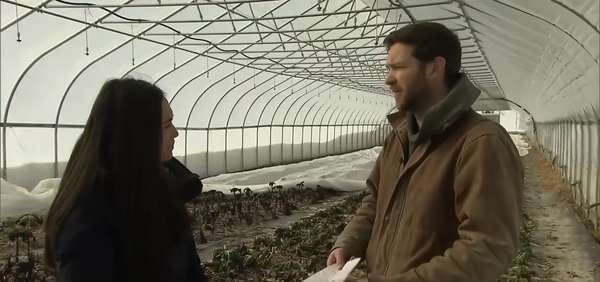Farmers face uncertain spring as federal funding freeze halts critical projects
- Replies 0
Spring is a time of renewal—fields come to life, livestock births are carefully planned, and farmers set the stage for the year ahead.
But this season, many farmers are finding themselves in a tough spot.
How did we get here, and what does this mean for small and mid-sized farms across the country?
The US Department of Agriculture (USDA) announced a sudden freeze in federal agricultural funding, leaving farmers struggling right as the spring growing season begins.
The freeze stems from an executive order issued by President Donald Trump on his first day in office, which paused disbursements linked to former President Joe Biden’s Inflation Reduction Act—including $19.5 billion allocated for agriculture-related conservation efforts.
Another $3.1 billion for "climate-smart" farm projects has also been placed on hold.
This funding was set to support essential farming initiatives such as rotational grazing, erosion prevention, solar panel installation, and irrigation improvements.
Now, thousands of farmers who had made investments based on expected grants are left in financial limbo.
While large-scale operations may be able to weather financial delays, small and mid-sized farms are at significant risk.
Many rely on federal grants to fund projects like fencing, soil conservation, and sustainable water management—all crucial for long-term success.
Farmers like Ang Roell in Massachusetts, who planned to use $30,000 in federal grants for deer-proof fencing and irrigation systems, now worry their orchards may not survive the season.
Without the infrastructure in place, crops are at risk of being destroyed by wildlife or drying out due to lack of water.
“We risk losing the plants because we can’t keep up with the watering schedule,” Roell said.
“The delay of time might not seem like a big deal for someone who is not a farmer. But it actually is.”
In Indiana, Brian Geier, a sheep farmer, was counting on a $10,000 USDA grant to expand his grazing area.
Expecting the funds, he committed to purchasing lambs this spring, but with no certainty of receiving the money, he’s been forced to borrow from a friend just to ensure the animals have a place to graze.
The freeze has hit climate-focused agricultural initiatives particularly hard.
The Trump administration has made rolling back climate-related policies a priority, leaving organizations like Pasa Sustainable Agriculture, which supports 200 climate-related projects, struggling to recover millions in delayed reimbursements.
The ongoing freeze has put both farmers’ and agricultural staff’s jobs at risk.
Source: NBC News / YouTube
In response to mounting concerns, the USDA recently announced a partial release of $20 million—a fraction of the billions still frozen.
Mike Lavender, Policy Director for the National Sustainable Agriculture Coalition, described it as “a pittance”, emphasizing that spring’s timing is critical, and the delay could have lasting consequences.
The USDA has not yet provided a timeline for when the rest of the funds will be released, leaving many farms unable to plan for the months ahead.
Despite these challenges, the agricultural community remains determined and resourceful.
Many farmers, like Roell, turned to the USDA for support after extreme weather events disrupted their businesses, only to now face uncertainty from a government-imposed delay.
Farmers have always had to adapt to unpredictable weather, fluctuating markets, and changing policies—but with the spring season already underway, time is running out for those waiting on critical funding.
With no clear answers on when funding will resume, farmers are forced to explore alternative solutions.
This could include adjusting crop and livestock strategies, seeking private loans, or scaling back planned expansions.
Meanwhile, the USDA and lawmakers face mounting pressure to unfreeze funds before long-term damage is done to small farms and rural communities.
At The GrayVine, we’ve covered major disruptions in the agricultural industry, and now another crisis is unfolding. The USDA admitted to mistakenly terminating multiple employees involved in a critical federal response effort—read here to learn more.
 Are you or someone you know affected by the funding freeze? How are you adjusting your plans this spring? Share your experiences in the comments below—your insights could help other farmers navigating this uncertain time.
Are you or someone you know affected by the funding freeze? How are you adjusting your plans this spring? Share your experiences in the comments below—your insights could help other farmers navigating this uncertain time.
Read more:
But this season, many farmers are finding themselves in a tough spot.
How did we get here, and what does this mean for small and mid-sized farms across the country?
The US Department of Agriculture (USDA) announced a sudden freeze in federal agricultural funding, leaving farmers struggling right as the spring growing season begins.
The freeze stems from an executive order issued by President Donald Trump on his first day in office, which paused disbursements linked to former President Joe Biden’s Inflation Reduction Act—including $19.5 billion allocated for agriculture-related conservation efforts.
Another $3.1 billion for "climate-smart" farm projects has also been placed on hold.
This funding was set to support essential farming initiatives such as rotational grazing, erosion prevention, solar panel installation, and irrigation improvements.
Now, thousands of farmers who had made investments based on expected grants are left in financial limbo.
While large-scale operations may be able to weather financial delays, small and mid-sized farms are at significant risk.
Many rely on federal grants to fund projects like fencing, soil conservation, and sustainable water management—all crucial for long-term success.
Farmers like Ang Roell in Massachusetts, who planned to use $30,000 in federal grants for deer-proof fencing and irrigation systems, now worry their orchards may not survive the season.
Without the infrastructure in place, crops are at risk of being destroyed by wildlife or drying out due to lack of water.
“We risk losing the plants because we can’t keep up with the watering schedule,” Roell said.
“The delay of time might not seem like a big deal for someone who is not a farmer. But it actually is.”
In Indiana, Brian Geier, a sheep farmer, was counting on a $10,000 USDA grant to expand his grazing area.
Expecting the funds, he committed to purchasing lambs this spring, but with no certainty of receiving the money, he’s been forced to borrow from a friend just to ensure the animals have a place to graze.
The freeze has hit climate-focused agricultural initiatives particularly hard.
The Trump administration has made rolling back climate-related policies a priority, leaving organizations like Pasa Sustainable Agriculture, which supports 200 climate-related projects, struggling to recover millions in delayed reimbursements.
The ongoing freeze has put both farmers’ and agricultural staff’s jobs at risk.
Source: NBC News / YouTube
In response to mounting concerns, the USDA recently announced a partial release of $20 million—a fraction of the billions still frozen.
Mike Lavender, Policy Director for the National Sustainable Agriculture Coalition, described it as “a pittance”, emphasizing that spring’s timing is critical, and the delay could have lasting consequences.
The USDA has not yet provided a timeline for when the rest of the funds will be released, leaving many farms unable to plan for the months ahead.
Despite these challenges, the agricultural community remains determined and resourceful.
Many farmers, like Roell, turned to the USDA for support after extreme weather events disrupted their businesses, only to now face uncertainty from a government-imposed delay.
Farmers have always had to adapt to unpredictable weather, fluctuating markets, and changing policies—but with the spring season already underway, time is running out for those waiting on critical funding.
With no clear answers on when funding will resume, farmers are forced to explore alternative solutions.
This could include adjusting crop and livestock strategies, seeking private loans, or scaling back planned expansions.
Meanwhile, the USDA and lawmakers face mounting pressure to unfreeze funds before long-term damage is done to small farms and rural communities.
At The GrayVine, we’ve covered major disruptions in the agricultural industry, and now another crisis is unfolding. The USDA admitted to mistakenly terminating multiple employees involved in a critical federal response effort—read here to learn more.
Key Takeaways
- Farmers across the US are facing major disruptions after the Trump administration froze billions in federal agricultural funding, delaying critical projects.
- Small farms are particularly vulnerable, with some pulling out of farmer’s markets and canceling contracts due to financial instability.
- Climate-related agricultural programs have been especially impacted, with millions in USDA reimbursements still owed to sustainable farming initiatives.
- A small fraction of funding has been released, but uncertainty remains over when the rest will follow, leaving farmers in limbo as the spring season begins.
Read more:







